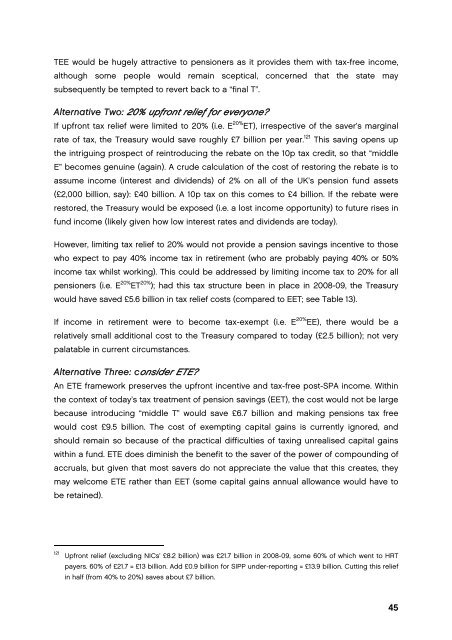Simplification is the key - Centre for Policy Studies
Simplification is the key - Centre for Policy Studies
Simplification is the key - Centre for Policy Studies
Create successful ePaper yourself
Turn your PDF publications into a flip-book with our unique Google optimized e-Paper software.
TEE would be hugely attractive to pensioners as it provides <strong>the</strong>m with tax-free income,<br />
although some people would remain sceptical, concerned that <strong>the</strong> state may<br />
subsequently be tempted to revert back to a “final T”.<br />
Alternative Two: 20% upfront relief <strong>for</strong> everyone?<br />
If upfront tax relief were limited to 20% (i.e. E 20% ET), irrespective of <strong>the</strong> saver’s marginal<br />
rate of tax, <strong>the</strong> Treasury would save roughly £7 billion per year. 121 Th<strong>is</strong> saving opens up<br />
<strong>the</strong> intriguing prospect of reintroducing <strong>the</strong> rebate on <strong>the</strong> 10p tax credit, so that “middle<br />
E” becomes genuine (again). A crude calculation of <strong>the</strong> cost of restoring <strong>the</strong> rebate <strong>is</strong> to<br />
assume income (interest and dividends) of 2% on all of <strong>the</strong> UK’s pension fund assets<br />
(£2,000 billion, say): £40 billion. A 10p tax on th<strong>is</strong> comes to £4 billion. If <strong>the</strong> rebate were<br />
restored, <strong>the</strong> Treasury would be exposed (i.e. a lost income opportunity) to future r<strong>is</strong>es in<br />
fund income (likely given how low interest rates and dividends are today).<br />
However, limiting tax relief to 20% would not provide a pension savings incentive to those<br />
who expect to pay 40% income tax in retirement (who are probably paying 40% or 50%<br />
income tax whilst working). Th<strong>is</strong> could be addressed by limiting income tax to 20% <strong>for</strong> all<br />
pensioners (i.e. E 20% ET 20% ); had th<strong>is</strong> tax structure been in place in 2008-09, <strong>the</strong> Treasury<br />
would have saved £5.6 billion in tax relief costs (compared to EET; see Table 13).<br />
If income in retirement were to become tax-exempt (i.e. E 20% EE), <strong>the</strong>re would be a<br />
relatively small additional cost to <strong>the</strong> Treasury compared to today (£2.5 billion); not very<br />
palatable in current circumstances.<br />
Alternative Three: consider ETE?<br />
An ETE framework preserves <strong>the</strong> upfront incentive and tax-free post-SPA income. Within<br />
<strong>the</strong> context of today’s tax treatment of pension savings (EET), <strong>the</strong> cost would not be large<br />
because introducing “middle T” would save £6.7 billion and making pensions tax free<br />
would cost £9.5 billion. The cost of exempting capital gains <strong>is</strong> currently ignored, and<br />
should remain so because of <strong>the</strong> practical difficulties of taxing unreal<strong>is</strong>ed capital gains<br />
within a fund. ETE does dimin<strong>is</strong>h <strong>the</strong> benefit to <strong>the</strong> saver of <strong>the</strong> power of compounding of<br />
accruals, but given that most savers do not appreciate <strong>the</strong> value that th<strong>is</strong> creates, <strong>the</strong>y<br />
may welcome ETE ra<strong>the</strong>r than EET (some capital gains annual allowance would have to<br />
be retained).<br />
121<br />
Upfront relief (excluding NICs’ £8.2 billion) was £21.7 billion in 2008-09, some 60% of which went to HRT<br />
payers. 60% of £21.7 = £13 billion. Add £0.9 billion <strong>for</strong> SIPP under-reporting = £13.9 billion. Cutting th<strong>is</strong> relief<br />
in half (from 40% to 20%) saves about £7 billion.<br />
45

















